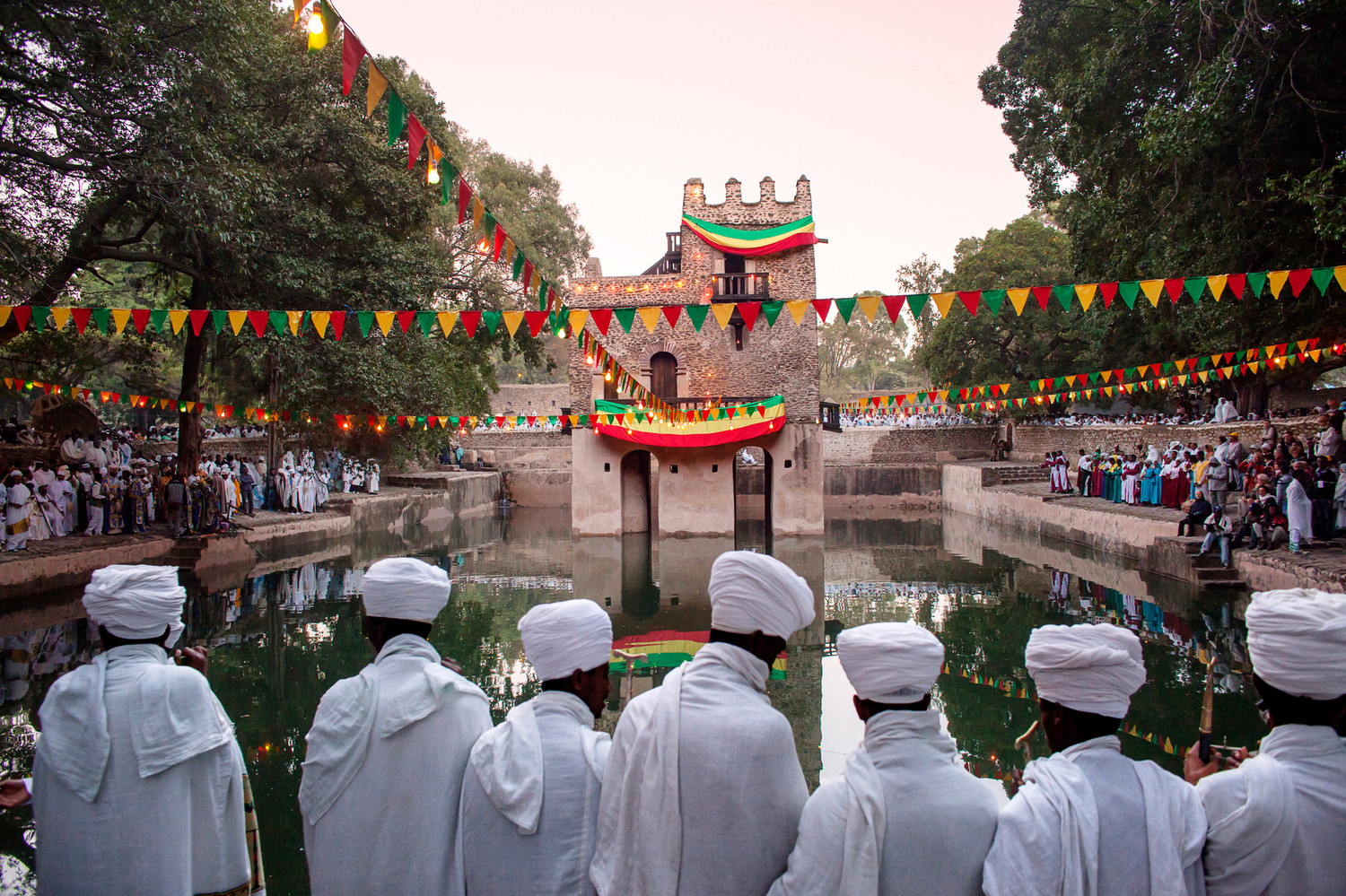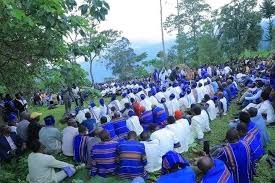
COMPILED BY STAFF REPORTER
Here are the reflections of visitor as well experiences she had in celebrating Timket, by Diane J. McDougall. She tried to share through using illustrative colorful words each of incidents she come across. In our today’s edition The Ethiopian Herald is offering this piece to help visitors feel celebration.
I’m fully aware that I don’t blend in. I might be wearing the traditional netela– a gauzy cotton white scarf with a splash of color and pattern along the ends. But at almost 5 feet 10 inches with pale hair, pale eyes and pale skin, I’m fooling no one. I am clearly a ferenji, a foreigner, joining hundreds of other foreigners and thousands of Ethiopians to celebrate the religious festival of Timket in the city of Gondar.
This lively, three-day observance is a study in contrasts: deep solemnity of faith intermixed with exuberance; the stark white of ceremonial dress dotted by flashes of color; ancient ritual captured on smartphones and tablets.
Timket traces its roots back to biblical times. In the early days of Judaism, a sacred box overlaid with gold was kept in the most holy place in the Jewish temple. Known as the Ark of the Covenant, it represented the coming Messiah.
Fast forward to the first millennium, when Jesus of Nazareth was hailed by many as that long-awaited Messiah. His earthly ministry was marked by baptism in the Jordan River. Ever since, Ethiopian Orthodox Churches have treasured and closely guarded their own model of the Ark of the Covenant, called a tabot.
The tabot only leaves the church during Timket, when it’s carried with great pomp to a nearby pool or river and immersed, along with many of the Christian faithful, in commemoration of Jesus’ baptism.
I’ve traveled to Ethiopia to join in that great pomp.
Timket is celebrated every January throughout the country. But many consider Gondar to host the best experience: Its 17th-century pool, surrounding one of the city’s many historical palaces, holds just the right amount of drama and history.
Eight colorful parades begin blending like a river’s tributaries.
In Gondar, the three-day affair starts (as it will later end) with smaller ceremonies at eight different churches. Then, eight colorful parades of choirs and priests — accompanied by Gondar’s entire population, it seems — begin blending like a river’s tributaries until they meet at the piazza. Their final destination is Fasiladas’ Bath, about 2 kilometers away.
The procession looks more like a noisy, undulating party, with thousands of people pressed shoulder to shoulder for miles. But it’s a slow party. To the crowded conditions, add the holy, ceremonial laying-down of rugs upon which the priests will step as they carry the tabots.
Each church’s high priest is swathed in colorful robes, with the tabot concealed in more layers of fabric high atop his head. He’s surrounded by other richly clothed priests, all protected from the beating sun by spectacularly embroidered umbrellas. As this huddle moves forward a few steps, young men roll up the rug recently trodden and prepare to dash with it to the front of the procession, to lay it down again. Tag teams of rug-rollers hustle back-and-forth endlessly under a bright sun.
In contrast to the priests’ vestments, most Ethiopians are draped in various layers of white, with threads of color as accent. Those who are clad in multihued holiday finery are mere spots of bright relief in the sea of clean white that spreads before us.
Caught in the chaos
My Japanese traveling companion and I are quickly swept up into the happy chaos that completely fills the street. Satoko speaks just enough Amharic to translate some of the singing and conversation that bubbles around us. She’s wearing a new netela, too, and we receive repeated appreciative glances and approving murmurs from the throngs pressing up against us.
I’m struck by the intricacy of the hairstyles, the generous spontaneity of the smiles and the level of energy. The joy that surrounds us reflects the optimism of the holiday itself — the beginning of all that Jesus would do for mankind during his time on earth.
Satoko and I break away from the crowd at one point, working our way through to the edge so that we can escape to the relative calm of the Neti Café. Cold bottles of Coke have never tasted so good. We share a flaky, lentil-filled sambussa (a savory baked pastry) and nibble on earthy Ethiopian chickpeas — plucking them off a branch.
Climax of the celebration
Four a.m. finds us climbing into another bajaj to return on near-silent streets to Fasiladas’ Bath for the official baptism ceremony. Within the outer compound, we see clusters of people gathered, candlelight illuminating their faces and their prayers. Others lie sleeping on the hard ground — the faithful who kept watch through much of the night.
As tourists, we’re admitted within the inner walls surrounding the bath. Everyone else who’s not part of the official ceremony is left outside. Dozens of eager young men climb the banyan trees that virtually swallow the walls, and they perch on the gnarled roots or climb high and higher still into their branches. Our seats give us a vantage point back over the wall, to where hundreds of white figures are dimly outlined in the pre-dawn light.
We wait for sunrise, and then we wait some more, watching the crowds and listening to hushed commentary from other tourists in other languages — all against the backdrop of singing and priestly chanting. I’m amused to watch numerous “junior” priests capture the unfolding action on their smartphones while BBC camera crewmen drag their cables back and forth at pool’s edge.
It’s not an uncomfortable wait. Endless scenarios below keep my attention. My netela, wrapped around my head and neck, keeps me warm. And the building expectancy energizes me.
Finally, sometime around 8 a.m., after a retelling of the story of Jesus’ baptism in Amharic, the priest blesses the water in the pool and leans down to dip in the tabot.
And then, unbelievably — even though I’ve been told to expect it — the slow, quiet waiting of Timket ends in an explosion of sound and water as hundreds of (mostly) young men and boys leap exuberantly into the pool, some from the high branches of the banyan. We’re baptized, too, in a sense, with sprays of holy water tossed up into the bleachers.
As the pool fills with splashing brown bodies, enthusiastic young tourists from behind me start climbing down to join in. Satoko and I eventually head toward the exit gates and back to the piazza, following the satisfied but tired crowd.
We end Timket back at Medihanealem Church, where Satoko and I had first joined the celebrants. More speeches, chanting, dancing. A huge colorful umbrella is upended and passed over the heads of those gathered, collecting donations for a mountain monastery.
For many, the festivities will continue for a few more hours. I, however — exhausted from the day — am grateful to walk the short distance back to our hotel, where I climb the stairs to my cool room and sit on the bed, the curtains behind me open to the balcony and the city’s ancient-meets-modern celebrations below.
Source: www.selamtamagazine.com
The Ethiopian Herald 16 January 2021






Login Laskar288– Rekomendasi Situs Slot Gacor Hari Ini Deposit Pulsa Tanpa Potongan